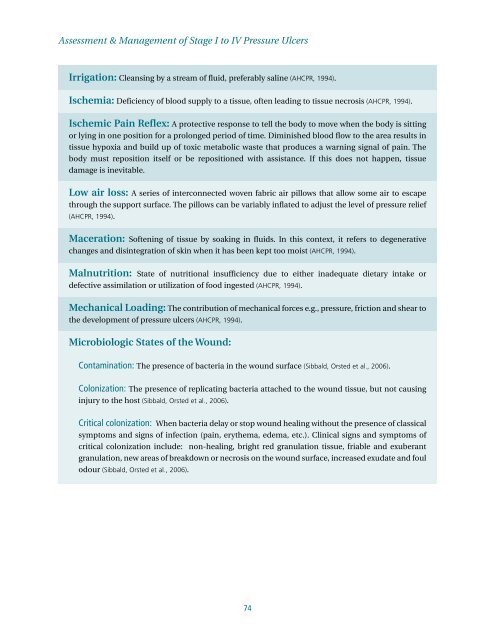RNAO BPG Pressure Ulcers Stage I to IV - Faculty of Health ...
RNAO BPG Pressure Ulcers Stage I to IV - Faculty of Health ...
RNAO BPG Pressure Ulcers Stage I to IV - Faculty of Health ...
You also want an ePaper? Increase the reach of your titles
YUMPU automatically turns print PDFs into web optimized ePapers that Google loves.
Assessment & Management <strong>of</strong> <strong>Stage</strong> I <strong>to</strong> <strong>IV</strong> <strong>Pressure</strong> <strong>Ulcers</strong>Irrigation: Cleansing by a stream <strong>of</strong> fluid, preferably saline (AHCPR, 1994).Ischemia: Deficiency <strong>of</strong> blood supply <strong>to</strong> a tissue, <strong>of</strong>ten leading <strong>to</strong> tissue necrosis (AHCPR, 1994).Ischemic Pain Reflex: A protective response <strong>to</strong> tell the body <strong>to</strong> move when the body is sittingor lying in one position for a prolonged period <strong>of</strong> time. Diminished blood flow <strong>to</strong> the area results intissue hypoxia and build up <strong>of</strong> <strong>to</strong>xic metabolic waste that produces a warning signal <strong>of</strong> pain. Thebody must reposition itself or be repositioned with assistance. If this does not happen, tissuedamage is inevitable.Low air loss: A series <strong>of</strong> interconnected woven fabric air pillows that allow some air <strong>to</strong> escapethrough the support surface. The pillows can be variably inflated <strong>to</strong> adjust the level <strong>of</strong> pressure relief(AHCPR, 1994).Maceration: S<strong>of</strong>tening <strong>of</strong> tissue by soaking in fluids. In this context, it refers <strong>to</strong> degenerativechanges and disintegration <strong>of</strong> skin when it has been kept <strong>to</strong>o moist (AHCPR, 1994).Malnutrition: State <strong>of</strong> nutritional insufficiency due <strong>to</strong> either inadequate dietary intake ordefective assimilation or utilization <strong>of</strong> food ingested (AHCPR, 1994).Mechanical Loading: The contribution <strong>of</strong> mechanical forces e.g., pressure, friction and shear <strong>to</strong>the development <strong>of</strong> pressure ulcers (AHCPR, 1994).Microbiologic States <strong>of</strong> the Wound:Contamination: The presence <strong>of</strong> bacteria in the wound surface (Sibbald, Orsted et al., 2006).Colonization: The presence <strong>of</strong> replicating bacteria attached <strong>to</strong> the wound tissue, but not causinginjury <strong>to</strong> the host (Sibbald, Orsted et al., 2006).Critical colonization: When bacteria delay or s<strong>to</strong>p wound healing without the presence <strong>of</strong> classicalsymp<strong>to</strong>ms and signs <strong>of</strong> infection (pain, erythema, edema, etc.). Clinical signs and symp<strong>to</strong>ms <strong>of</strong>critical colonization include: non-healing, bright red granulation tissue, friable and exuberantgranulation, new areas <strong>of</strong> breakdown or necrosis on the wound surface, increased exudate and foulodour (Sibbald, Orsted et al., 2006).74
















